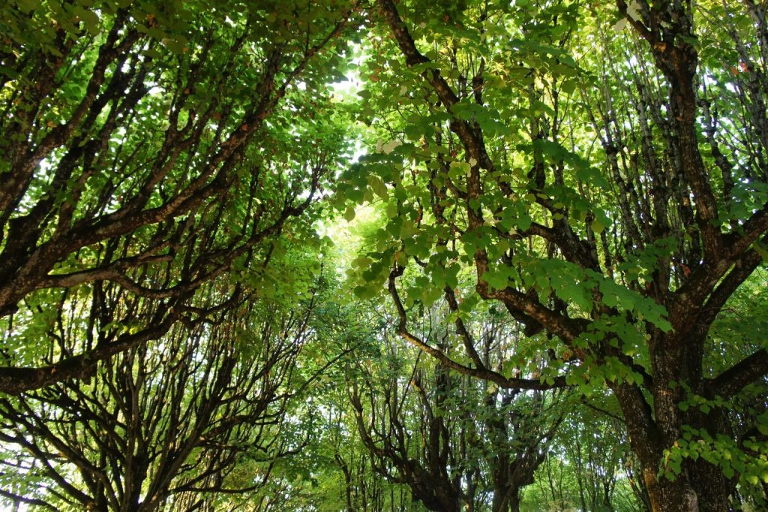Ed. Note: Part 1 of this series was published on Resilience.org here.
This is the second part of a series on indigenous food systems with Diné artist, activist and scholar Lyla June. In Part One: Kelp Gardens, Piñon Forests, she shares some of her personal journey with food and agriculture and what inspired her to focus the next stage of her life on traditional food systems and language.
In Part Two, she delves more deeply into the eye-opening science coming forward about pre-colonial land management practices and the sophisticated foodscapes co-created with nature over the centuries. This piece was drawn from a presentation to the Sovereign Sisters Gathering at Borderland Ranch in South Dakota.
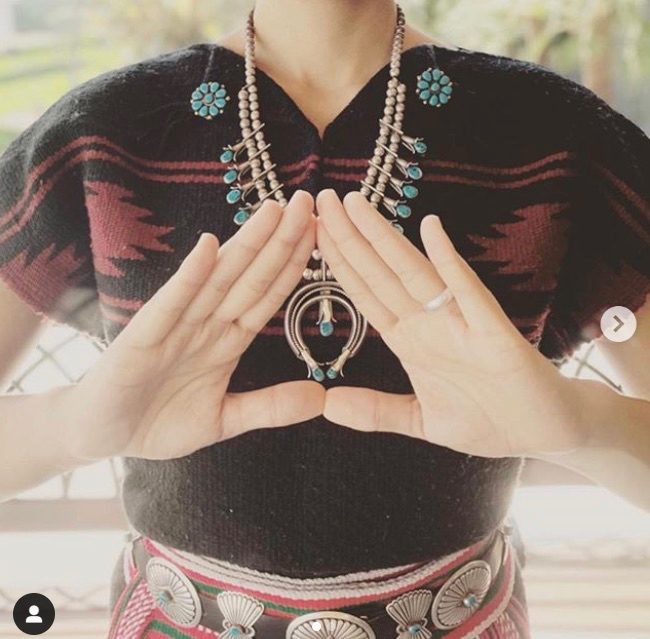
The squash blossom, a recurring image in Diné art and jewelry, is a part of the Diné traditional agricultural and food system. Lyla June/Instagram photo in honor of Mauna Kea.
I’m introducing my clans from the Diné nation; our first clan is the Black Charcoal Streak Division, aka Zuni People; Division of the Red-Running-Into-the-Water People of the Diné Nation, also currently known as the Navajo. My father’s mother is of the Cheyenne clan, Tsétsêhéstâhese. My mother’s father’s mother is the Salt Clan of the Diné, and my father’s father’s mother is the Scandanavian clan. Those are the main matrilineal lines that I carry.

There’s a huge mythology that native people here were simpletons, they were primitive, half-naked nomads running around the forest, eating hand-to-mouth whatever they could find. That’s how Europe portrays us. And it’s portrayed us that way for so many centuries that even we’ve started to believe that that’s who we were. The reality is, indigenous nations on this Turtle Island were highly organized. They densely populated the land and they managed the land extensively. And this has a lot to do with food, because a large motivation to prune the land, to burn the land, to reseed the land, and to sculpt the land, was about feeding our nations. Not only our nations, but other animal nations as well.
This story is a part of the ongoing Women of Standing Rock series.
So for instance, one of the things I’m interested in is the soil cores that they get out of the Earth; they’re very thin but they’re maybe 10 meters deep, and you can analyze the fossilized pollen from the bottom up to the top. And you can date each layer to see what time it was deposited; and there also is fossilized charcoal, and this is evidence that the people would burn the land routinely and extensively.
There’s a soil core from what we now call Kentucky that goes all the way back to 10,000 years ago. And it shows that from 10,000 years ago up to about 3,000 years ago, there was a mainly cedar and hemlock forest. But about 3,000 years ago the whole forest composition changed to a black walnut, hickory nut, chestnut, acorn forest. Also they noticed that a lot of edible species like goosefoot and sumpweed, their pollen was found around that time. So these people – whoever moved in around 3,000 years ago —radically changed the way the land looked and tasted.
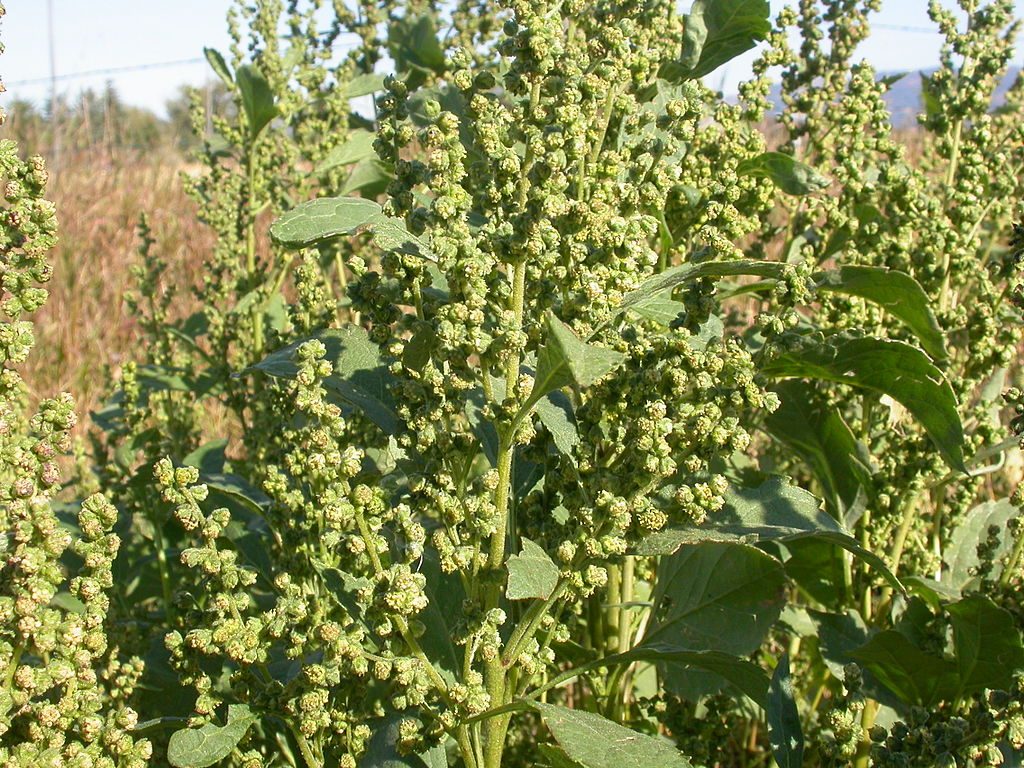
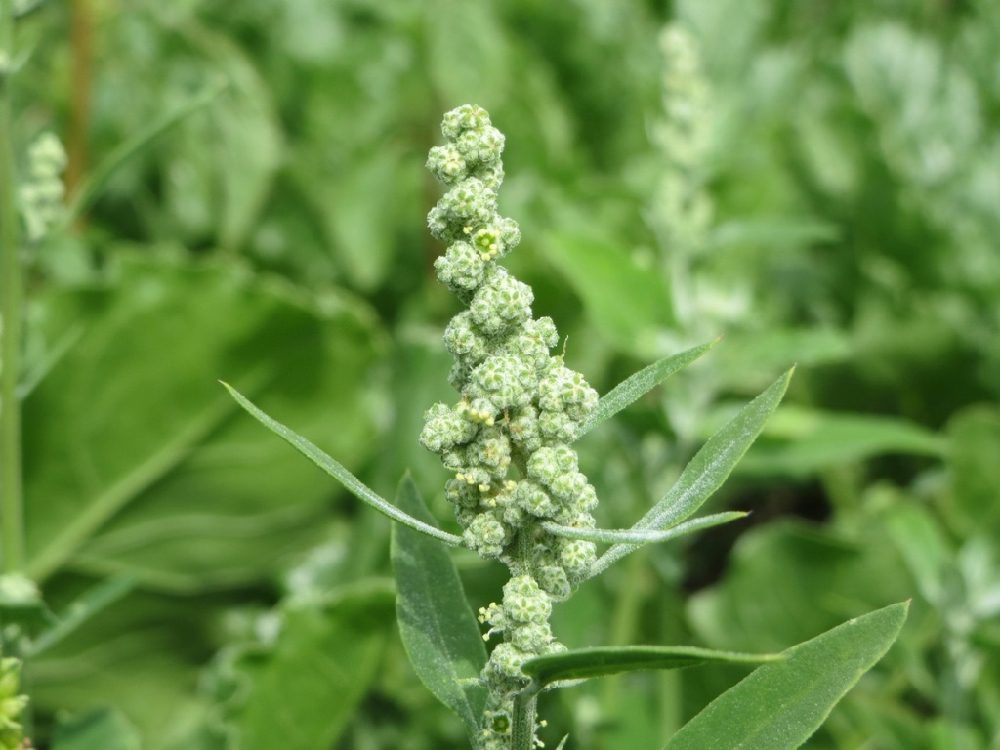
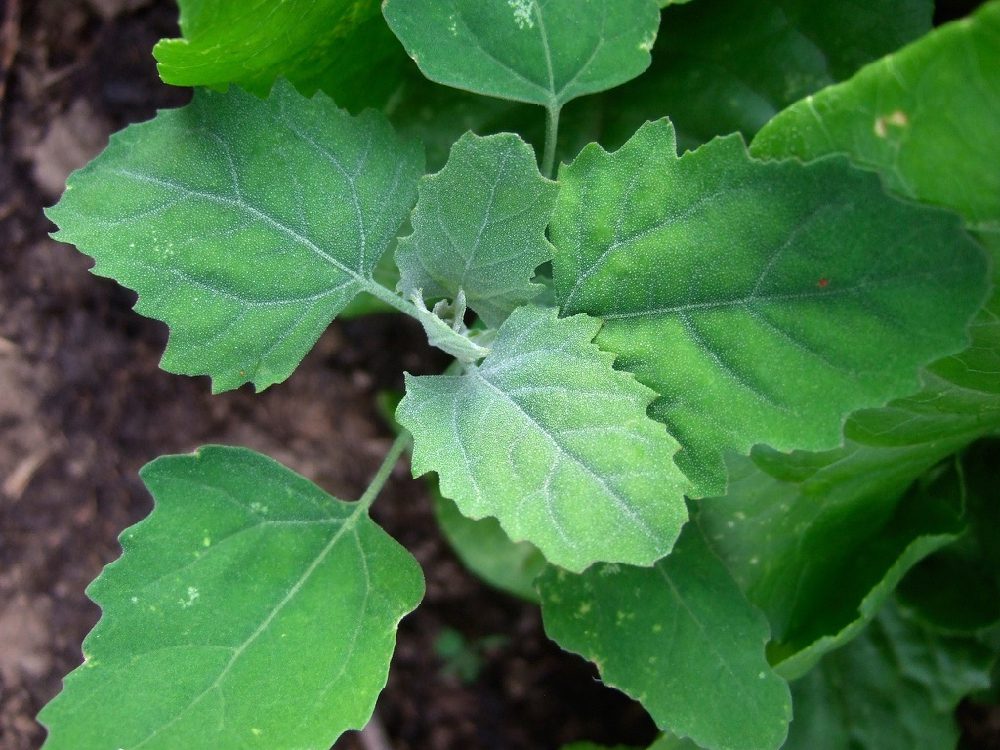
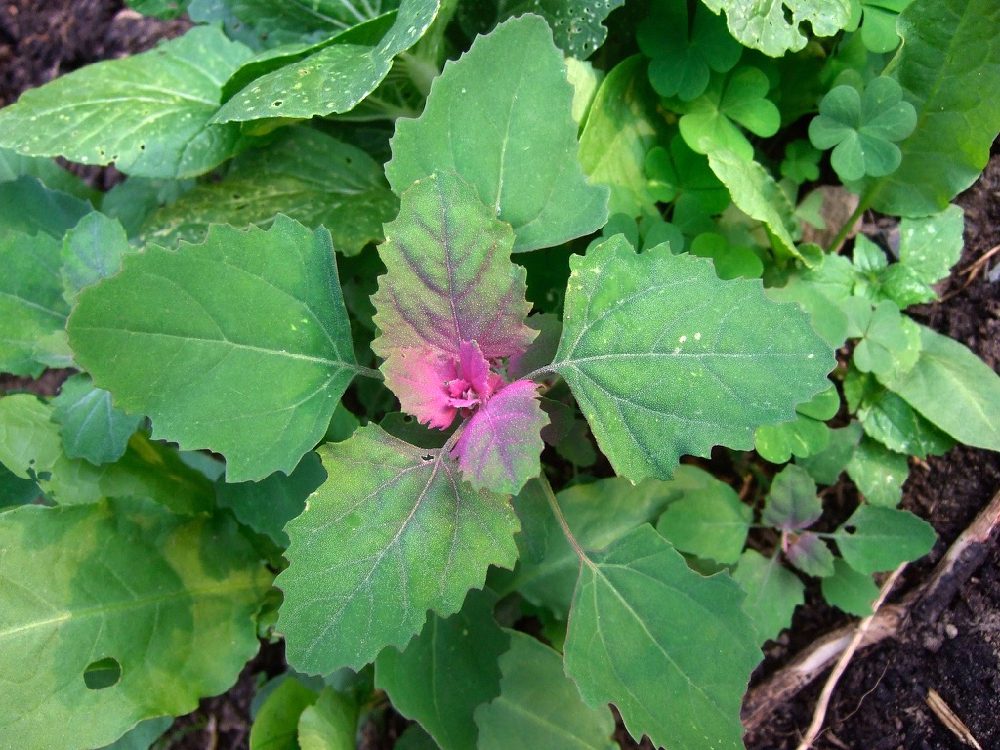
From top to bottom: sumpweed, or marsh elder (iva xanthafolia), and goosefoot or lambsquarter (closely related members of the chenapodium family) (Creative Commons photos: respectively, Matt Lavin from Bozeman, Montana; Pixhere; and Wendell Smith from Flickr.
This is a type of what we call anthropogenic or human-made foodscapes, where we would shape the land – not in a dominating way but in a gentle way. Similarly, in the Amazon you have these food forests where again they look at the soil cores and you have a lot of fruit trees, and they call it hyper-dominance, which means naturally you wouldn’t see that many fruit trees and nut trees. So you couldn’t know it but human beings really made the Amazon rainforest as we know it. And they also utilized the terra preta soil composting technology where they would generate highly fertile soils that were 10 feet deep and they would use their refuse and their compost to generate these black soils. And you only find the terra preta or black earth near these human settlements.
Human beings are meant to be a gift to the land. Another example is in Bella Bella, BC, where the kelp gardens are actually planted by hand by the Bella Bella Nation. And these kelp gardens provide the spawning ground for the herring, which lay their roe and their eggs – and their roe is a major foundation of the whole web of life there. The humans eat the roe, the wolves eat the roe, the salmon eat the roe, and that in turn feeds the killer whales — everyone eats the roe, and everyone eats the things that eat the roe. And without this human touch along the coastline, the whole ecosystem would be compromised.

Fish in a kelp forest off the coast of California.Ralph Pace/The Nature Conservancy
What we’re finding, and what European scientists are finally figuring out, is that human beings are meant to be a keystone species. And a keystone species is a species that if you take it out, the whole thing unravels.
When I was at the Parliament of World Religions there was a Yoruba elder there giving a speech. And he said in our language, the word for human means “chosen one.” And he said, “We are called chosen ones because we were chosen by Creator to take care of the Earth. We are the chosen species to steward her and to facilitate.” We are here for a reason.
Every being is here for a reason – every rock, every deer, every star, every person is here – Creator doesn’t just make things that don’t have a purpose or a function or a part in the puzzle. And so we as human beings are trying to bring the human being back into the role of keystone species, where our presence on the land nourishes the land. And one of the women I’m learning from for my doctoral pre-research is saying – I don’t like the word sustainability. We’re not just going to sustain ourselves; that’s a low standard. I’m going for enhanceability. The ability to enhance wherever I walk. The ability to make it better than when I found it.
So it depends on where you are from; what biome or ecosystem you live in, that will determine how we are meant to work with the land. For example the Amah Mutsun Nation, which is indigenous to what is now called Santa Cruz, California, have a ceremony that they do with the oak trees. And if you look at their oak trees, they’re very hard and fire resistant – because they co-evolved with Amah Mutsun people for tens of thousands of years. And he said what we do is, we have a rule of thumb. We say only 14 trees per acre. He said, these days you go around and you see 200, 400 trees per acre. The land can’t handle that. All those trees and all those plants are starving. They’re starving because there’s limited nutrients and limited water in the soil. So what our people used to do is we would create savannahs where there are 14 trees per acre.
And what we’d do each year is we’d cut down the low-hanging, older branches so that they wouldn’t get burned. And we’d gather all the leaves together and we would burn around the oak trees. And he said the smoke would go into the leaves and it would smudge the oak trees. He said we would bless the oak trees with the smoke. And the oak trees began to get used to that. And they miss us, because we hadn’t been doing that. He said the smoke would go up and burn or suffocate the pests, so you’d have a healthier acorn crop to choose from. And all the bugs would fall into the fire. And all the saplings would die off. So only the hardiest and strongest plants would arise, he said. So this is just one example of the very important role of fire in maintaining the health of the land.
He said we would do this all throughout what is now called California – and because we have been prohibited from our burning, we now have these catastrophic fires throughout California. He said that this has to come back. He said we wouldn’t just change the land however we wanted it; we would look at what was going on on the land, and we would preference the food-bearing plants, but we would listen to her, and then create what she had there and tend it. So European explorers and pirates would come to the Eastern seaboard and would marvel at the forests there, and they would say, wow, these forests are like parks. There was space between the trees, there were deer walking through; and they said wow, the wilderness here is beautiful.
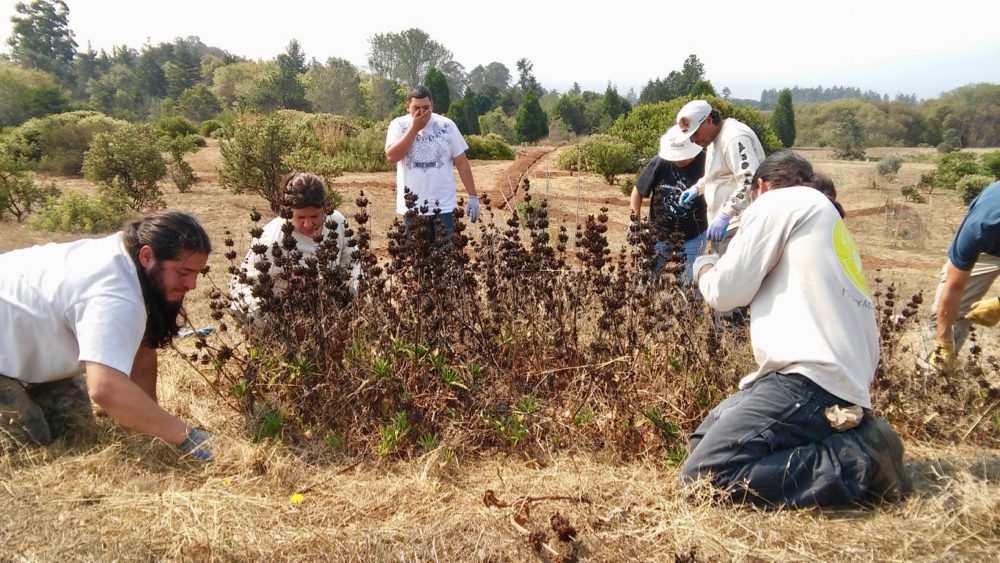
Native Stewards tend hummingbird sage (Salvia spathacea) at the Amah Mutsun Relearning Garden at the UC Santa Cruz Arboretum with AMLT Research Associate Rick Flores.(Photo: Amah Mutsun Land Trust)
But wilderness is a very interesting word that we need to examine and reconsider how we use it, because it’s not necessarily wild. If you call it wilderness, for one thing, you separate yourself from it. Like that’s that, and I’m over here in the non-wilderness. But secondly, it wasn’t so wild, actually, because it was very, very tended by human hands.
But this is not necessarily a bad thing. My father for example says, “We should just leave nature alone – don’t touch it, because it’s perfect the way it is.” But we’re saying you have to find a middle ground – where you don’t leave marks on the Earth, you don’t harm the Earth, but you’re also allowed to go in and gather. You’re allowed to go in and harvest. You’re allowed to go in and spread seeds as you harvest.
That’s what the Amah Mutsun elder said. He said, first we give one shake for the birds. And one shake for the next year’s planting. And then we take the seeds. So you’re regenerating as you’re harvesting. And the harvest was the way in which we’d do these management practices.
So the Great Plains and the buffalo we hunt are also anthropogenic. People don’t know that but people used to call them Indian Summers because the sky would be black because there would be fires all over. And we would manage the Great Plains with fire. And yes, we hunted buffalo – but we hunted in the grasslands we made for them.
For example, there’s something known as successive regrowth, where if you burn an area one year later it will have one set of flora and fauna. Two years later it will have another set of flora and fauna. Three years later it will have another set of flora and fauna. Four years later it will have another set of flora and fauna. So you had patches all over the Great Plains that were at different stages of regrowth. Maybe this one was burned a year ago; this one was burned two years ago. Three years ago, four years ago. And each one had a different set of flora and fauna, and in that manner we’d enhance the biodiversity of the area. That’s the kind of genius our ancestors held.
But even today you’ll see our elders thinking that we weren’t all that smart. But we have to understand that 98% of our people were wiped out before they even started writing stories about us. Before they even started taking pictures of us. Every picture you see – those black-and-white pictures – were taken after 98% of the population was decimated – or at least 90% – by disease and massacre.
So the native nations we know of today – Cherokee, Seminole – these are survival bands. These are the 2% who survived and got together and tried to make things work. They do not reflect the original composition of the people. It doesn’t belittle them, it’s just beckoning the world to look deeper. To understand that the story that unfolded on this continent is much greater than what any of us had been told. And that story needs to be told. And when we think about the original composition of the people, it was vast, and it was highly organized. We are the ones who inspired Ben Franklin to generate this new thing called democracy.
The Iroquois Confederacy is the blueprint for American democracy – which at the time was very revolutionary, coming from monarchies. So we had technologies not only that enhanced the Earth but we had social technologies as well. And we didn’t learn these technologies just magically. We learned them through trial and error. The Peacemaker of the Iroquois Confederacy only came after centuries of war. We had war here, we had slavery here, we had horrific things go on here.
My people, we descend from the Chaco Canyon people. Chaco Canyon is revered as this great archaeological site – but if you really dig into it, we had caste systems there, we exhausted the land, we manipulated the water, we had running water there – which isn’t necessarily bad – but we weren’t honoring the way it wanted to flow. And Creator sent us a drought. And it was the youth of Chaco Canyon who decided that we were going to not live that way anymore. And so when the drought came it gave us the courage to change. And we left; we abandoned it.
And as Diné people, we’re not supposed to go back there. We say, That era is over. And so from that fire was born a new society.
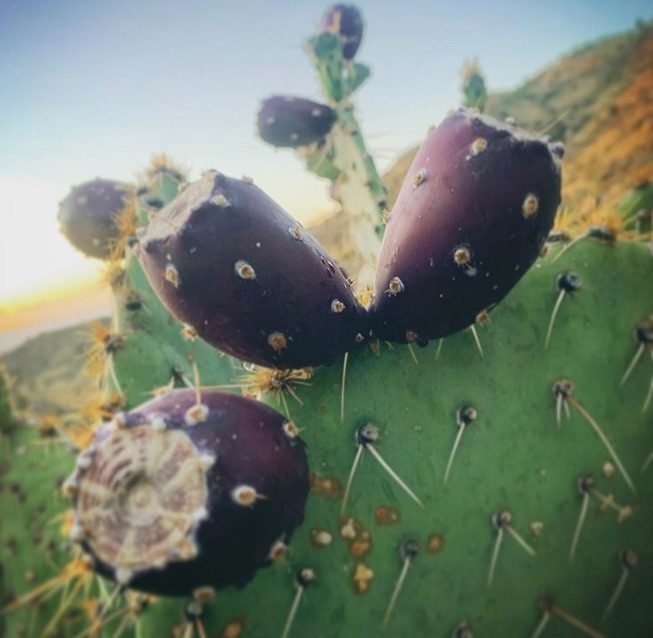
Highly nutritions prickly pear cactus (nopal). Lyla June Instagram photo:Learn more here.
All of these kinship terms: my maternal grandmother, my paternal grandmother, my sister, my younger brother – all those terms of endearment, of humbling yourself, of preciousness, came from that period of complete chaos, where we learned the hard way that inequality does not work. That altering the Earth does not work.
So that’s true for a lot of Native nations. We’ve been here for hundreds of thousands of years. They try to say we’ve just been here since the Bering Strait. No. They just found mastodon bones in San Diego that had human carvings on them. 130,000 years old. And of course all the Western scientists don’t want to believe it. They say, “No, no, no, you must have dated it wrong. No, those can’t be human markings.” No, we didn’t date it wrong. And those are definitely human cuts. Someone cut that mastodon up with a tool. There’s no doubt about it. But they don’t want to hear it, because they want our time period to be shortened. Because then we never really were here anyways. And if they exterminated us – well, we hadn’t been here that long. They don’t want to face the truth that we’ve been here a very, very, very, very long time. And this is our home, and we do have a right to be here.
They also don’t want to face the truth that we were highly civilized. More civilized than they – in the sense that we did not leave marks on the Earth. If you leave a mark on the Earth, it meant you’d done something disrespectful – marks that you could see hundreds of years later. So the archaeologists are like, there were no people here – you would see aqueducts, you would see pyramids, you would see roads – you would see something. And we say, No. We never made marks on the Earth that lasted more than a decade at the most. Because we were the original “Leave No Trace.” But we did leave one thing in our wake, and that was biodiversity.
And so the archaeologists don’t even have the tools to detect how long we have been here because they’re looking for the wrong things.
They say, “Oh, Chaco!” and “Oh, here’s a Mayan city in Guatemala!” The Mayans left that city the same way we left Chaco, because we decided we were not God. They went back to the forest.
So that’s why the Maya cities collapsed — they left the cities on their own because they decided they were not God. They were going to live humbly again. They’d kind of been there, done that.
So now here we are with all our fancy technology and we can’t even close the wealth disparity gap. All of our PhDs going to the moon and we can’t even keep our oceans clean. So we have all this knowledge but we have no wisdom. So here we are learning, just like our ancestors learned – inequality does not work. Patriarchy does not work. Rape culture does not work. That’s why White Buffalo Calf Woman had to come – the Lakota were steeped in rape culture. And it wasn’t working. Their whole world was unraveling. And White Buffalo Calf Woman came to say, “This is how you treat the women.” Then it gave birth to a great nation that we learn from today.
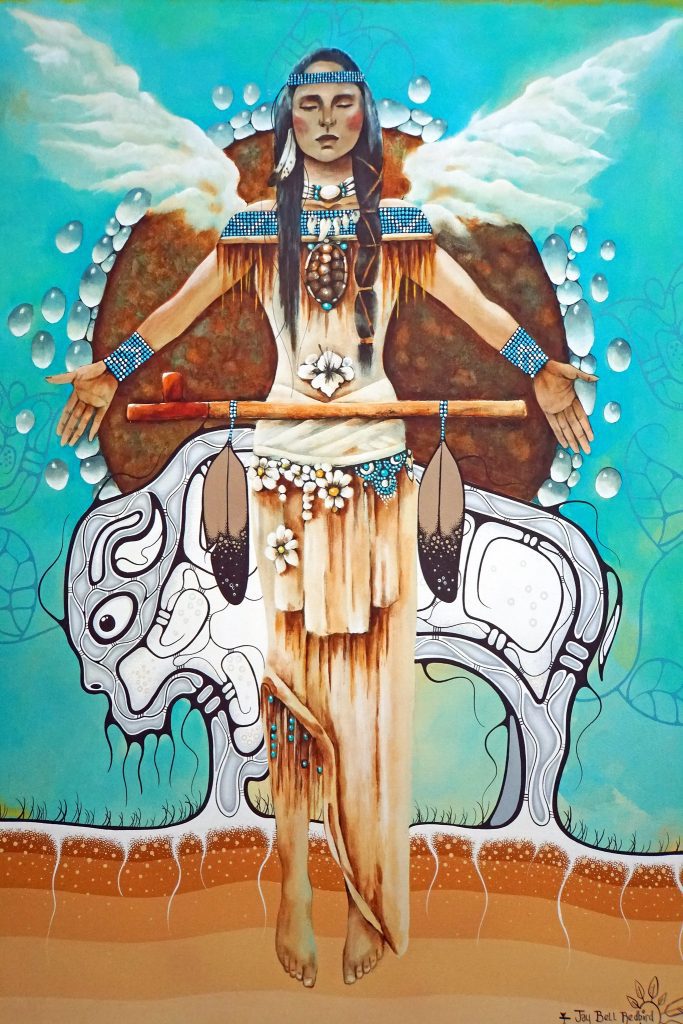
White Buffalo Calf Woman by Jay Bell Redbird and Helina Stopyra. Photo courtesy Dennis Jarvis via Flickr.
And so we are in the process as a species of learning the hard way. And it does suck – it’s hard. We’re taking out a lot of species just to learn this lesson. But we will emerge wiser, and we will emerge more sovereign. We have to; it’s the only way. Only sovereignty is sustainable.
So when we circle back around to food, it’s not so much what you do but why you do it. What you do can change from biome to biome; but why you do it remains the same. You do it to honor what Creator has made; you do it to enhance the land you live on. You do it to diversify genes at every opportunity; and you do it to honor the natural flow of water. You do it in the spirit of selflessness, in the spirit of service, in the spirit of community. And as long as you’re doing that, the technical skills will follow.
And so when we talk about food sovereignty, I know the theory but I need to practice a lot more. I don’t know a whole lot about on-the-ground stuff, which is what I’ll be spending the next few years doing. But I think the core principles are: don’t leave marks on the Earth; honor what Creator has made; honor the women; honor women’s leadership; and diversify – diversify – diversify.
They talk about the Andean people having 400 types of potatoes. This helps us in a time of climate change because one potato does good in a drought; one potato does good in a rainy season. And they look at the signs of the plants – oh, this one’s blossoming early; that means it’s going to be a rainy season. Or they look at the stars at a certain time of year; this is going to be a wet season. But they still prepare for every situation. They might plant a little more of what they expect to work. But they’re still going to plant all the different types.
When we went to Villa Rica, Peru, that had so many fruits I’ve never seen in my live. They have fruits that probably most of us have never even heard of. When I went to a restaurant to order a juice — every restaurant has juice – you could order from 12 different kinds of juice. How many kinds of juice do we have? Apple juice, orange juice, maybe some kind of cranberry juice if we’re lucky – but that’s Minute Maid, right? That’s your palate. So our corn, too, was smaller, but it had way more nutrients in it. And when Cheryl and I went to Cuetzalan, Puebla, I had the most delicious banana in my life – and it was only this big. (uses fingers to measure about 6 inches)
And so those bananas – we don’t need to blow things up with our GMOs. Because it dilutes the nutrient content; we don’t need to eat as much as we eat. We don’t even know what it’s like to eat normally, to eat like a normal human being, the way Creator intended. We eat and eat and eat, and we’re still hungry. Back in the day, the Chia seeds would sustain a warrior for a whole day.
It’s hard to know where to go if you’ve never been exposed to the truth of what happened on this planet, and how it flourished – huge civilizations. There were 80 languages spoken in California alone. Eighty languages that were mutually unintelligible. Incredible things happened here – and a lot of that has been erased or we’re just not able to find it. So expanding your imagination about what happened here will help us set the record straight about who was primitive and who was civilized – and will also help us generate that world again. Maybe through thinking about which seeds we plant. Maybe trying to have 12 different kinds of squash, 12 different kinds of corn in your garden. Maybe instead of cutting down a forest to make room for a farm, realize the forest already is a farm, if you know how to take care of it – it will make food for you, way better than any monocrop.
So it’s time for us to remember that a forest is a farm. And if it’s not a farm, delicately, respectfully, carefully turn it into a farm. Don’t cut it down.
Lyla June shares her perspective on the deeper meaning of Climate Change and her powerful song “All Nations Rise”. From the recent webinar “Responding to runaway Climate Change: Indigenous Wisdom for Planetary Health”, hosted by EARTHwise Centre and The Four Worlds International Institute.
Teaser photo credit: Temperate broadleaf and mixed forest. (CC Public Domain)


